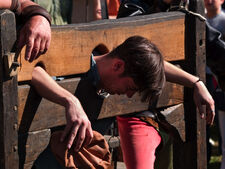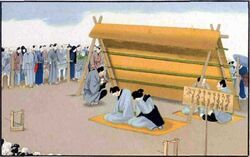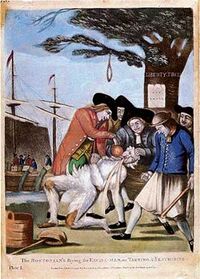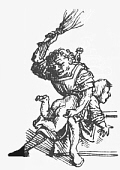Assessment |
Biopsychology |
Comparative |
Cognitive |
Developmental |
Language |
Individual differences |
Personality |
Philosophy |
Social |
Methods |
Statistics |
Clinical |
Educational |
Industrial |
Professional items |
World psychology |
Social psychology: Altruism · Attribution · Attitudes · Conformity · Discrimination · Groups · Interpersonal relations · Obedience · Prejudice · Norms · Perception · Index · Outline
Public humiliation was often used by local communities to punish minor and petty criminals before the age of large, modern prisons (imprisonment was long unusual as a punishment, rather a method of coercion).
Shameful exposure[]

punishment in a Pranger
This involved a variety of methods, most often placing a criminal in the center of town and having the local populace enact a form of "mob justice" on the individual. The punishment of public humiliation could range from anything to an offender being forced to relate his crime (Such as by exaggerated physical parody, a 'shame flute' for a bad musician or a giant rosary for someone late to church (Applications of the 'poetical justice' principle of mirror punishment).) or just of condemnation (schandstenen (Dutch: "stones of shame", worn at the neck)).
The offender could alternatively be sentenced to remain exposed in a specific public place, in a restraining device. The arsenal in the Low Countries included the schandstoel ("Chair of shame"), the kaak or schandpaal ("pole of shame", a simple type of pillory), the draaikooi, customary for adulteresses, and the schopstoel (A scaffolding which one is kicked off to land in mud and dirt).
In the more extreme cases being subjected to verbal and physical abuse from the crowd, which could have serious consequences especially when the hands are not free to protect himself. Some sentences actually prescribe additional humilitation, such as shaving, or combine it with painful corporal punishments, see below.
- In Colonial America, common forms of public humiliation were the stocks and pillory, imported from Europe. Nearly every sizable town had such instruments of public humiliation, usually at the town square. Historic public humiliation displays can still be seen in the historic Virginia town of Colonial Williamsburg.

Man and woman undergoing public exposure for adultery in Japan, around 1860
In pre-World War Japan, adulterers were publicly exposed purely to shame them.
In the modern age, judicial public humiliation punishment has largely died out, most importantly when it is outlawed as by the United States Constitution since public humiliation is today considered cruel and unusual punishment, which is banned by the UN Convention on Human Rights, but not precisely defined. This is why some judges are allowed to use shaming as a form of punishment, whereby an individual may have to parade in public with a sign explaining their behavior and misdeed.
Just like painful forms of corporal punishment, it has parallels in educational and other rather private punishments (but with some audience), in school or domestic disciplinary context, and as a rite of passage. Physical forms include being forced to wear some sign such as donkey ears (simulated in paper, as a sign one is--or at least behaved--proverbially stupid), wearing a "Dunce Cap", having to stand, kneel or bend over in a corner, or repeatedly write something on a blackboard ("I will not spread rumors" for example). Here to physical discomfort or even pain can be added, such as having to hold heavy objects or kneeling on an uneven surface. Like physical punishment and harsh hazing, these have become controversial in most modern societies, in many cases leading to legal restrictions and/or (sometimes voluntary) abolishment.
Painful humiliation[]

The 1774 tarring and feathering of British Commissioner of Customs John Malcolm 4 weeks after the Boston Tea Party
Apart from specific methods essentially aiming at humiliation, several methods combine pain and humiliation.
In some cases, pain or at least discomfort is insignificant or rather secondary to the humiliation, as school children made to kneel facing the blackboard, possibly on a hard object. In other cases they are roughly matched, as assuming such position while holding heavy objects.
Especially in judicial use the combination often results in a very severe punishment.
Public punishment[]
The simplest is to administer painful corporal punishment in public - the major aim may be deterrence of potential offenders - so the public will witness the victim's fear and agony. This can either take place in a town square or other public gathering location such as a school, or take the form of a procession through the streets. This was not uncommon in the sentences to Staupenschlag (whipping or birching, generally on the bare buttocks) in various German-speaking states, till the 19th century. A naval equivalent was flogging through the fleet on a raft taken from ship to ship for consecution installments of a great total of lashes, that could even be lethal).

Medieval schoolboy birched on the bare buttocks- spanking was often on the spot
- The humiliation is generally intensified if the victim is unclothed (either partially or completely) as the exposure leaves the victim feeling vulnerable and helpless.
- Even when not strictly public, humiliation can still be a psychologically "painful" aspect of punishment because of the presence of witnessing peers (such as fellow prisoners), relatives, staff or other onlookers, or simply because the tormentor witnesses how self-control is broken down. This is also true for punishments in class.
- Sexually promiscuous women and girls are sometimes punished by having their pubic hair cut short or their genital areas shaved bald; this is often done in public in front of a crowd.
- Public shaving was also applied to (true or alleged) collaborators after the Allied liberated occupied territories from the Nazi troops; being thus marked, they would remain in danger from molestation.
Torture marks[]
- The humiliation can be extended - intentionally or not - by leaving visible marks, such as scars, notably on body parts that are normally left visible. This also serves as a virtually indelible criminal record.
- This can even be the main intention of the punishment, as in the case of scarifications, such as branding. It invariably is essential in forms of mutilation, such as (ear) cropping, though the functional loss is even greater; pain may even be intentionally minimized as in the case of surgical amputation, eliminating the risk of accidental death.
See also[]
- fi:Häpeärangaistus
| This page uses Creative Commons Licensed content from Wikipedia (view authors). |